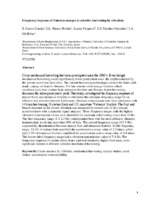Frequency response of Valencia oranges to selective harvesting by vibration
Autor
Castro García, Sergio
Blanco Roldán, Gregorio L.
Ferguson, Louis
Sánchez González, E.J.
Gil Ribes, Jesús
Materia
Citrus sinensis (L.) OsbeckMechanical harvesting
Canopy shaker
Trunk shaker
Acceleration transmissibility
METS:
Mostrar el registro METSPREMIS:
Mostrar el registro PREMISMetadatos
Mostrar el registro completo del ítemResumen
Citrus mechanical harvesting has been investigated since the 1960’s. Even though mechanical harvesting could significantly lower production costs, the implementation by the private sector has been slow. The current harvesting technologies detach the fruits with trunk, canopy or branch vibration. For late-season sweet orange varieties which simultaneously bear mature fruit, immature fruitlets and flowers shaker harvesting decreases the subsequent year’s yield. This study, investigated the frequency response of mature fruits and immature fruitlets to determine the optimum frequency range for an efficient and selective harvest. Laboratory vibration transmission tests were conducted with 14 branches bearing 76 mature fruits and 151 immature ‘Valencia’ fruitlets. The fruit and branch response to the forced vibration was measured by several sets of five triaxial accelerometers with a dynamic signal analyser. Three frequency ranges with the highest vibration transmission values were identified for mechanical harvesting lower than 10 Hz. The first frequency range (1.5-2.5 Hz) corresponded best with the most efficient vibration transmission, involving more than 90% of fruit. The second frequency range (4.5-5 Hz) successfully discriminated between mature fruit and immature fruitlets. In this frequency range, 53.4% of mature fruit amplified the acceleration a mean value of 2.2 times, while only 7.3% of immature fruitlets amplified the acceleration with a mean value of 4.4 times. The lowest third frequency range had a vibration transmission value of 7-8 Hz. The frequency response of mature citrus fruits, and their markedly higher fruit mass, were significant factors in efficient selective mechanical harvesting.

